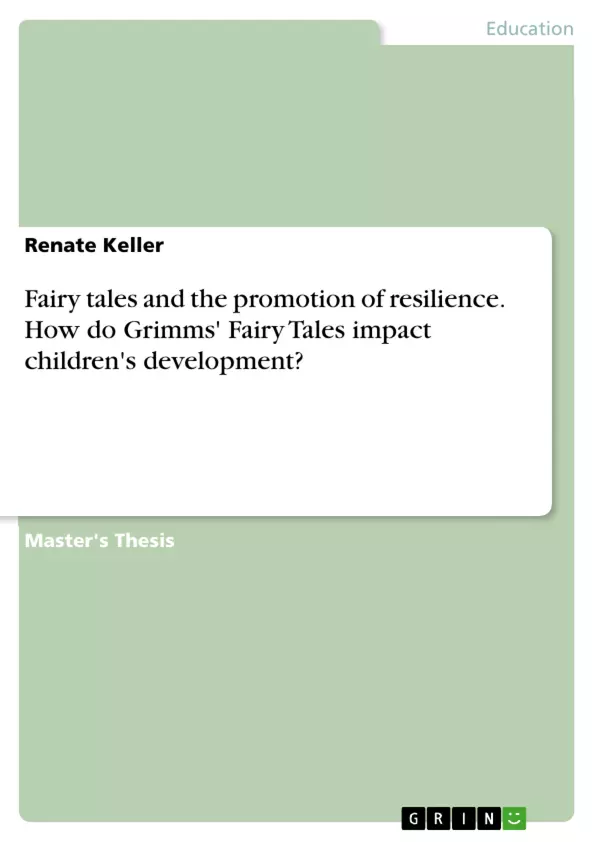Resilience is the inner resistance of a person. It helps them to cope better with difficult tasks. With strong resilience, children and young people go through life confidently and independently. However, the development of resilience depends on various factors.
One of these factors is the behavior of teachers and special educators. Renate Keller shows in her publication that telling fairy tales also promotes resilience. The courageous actions of the protagonists inspire especially children in their own behavior.
Fairy tales create inner images that strengthen learners in everyday life. The good ending in fairy tales supports children in their courage to face life and strengthens both resilience and social protective factors. Keller examines four fairy tales by the Brothers Grimm for their resilience-promoting effect.
Table of Contents
- 1 Introduction
- 1.1 Starting situation
- 1.2 Questions
- 1.3 Procedure
- 2 The term resilience
- 2.1 Resilience models
- 2.2 Framework model of resilience
- 2.3 Summary Resilience Models
- 2.4 Protective factor concept
- 2.5 Risk factor concept
- 2.6 Interaction of risk and protective factors
- 2.7 Opportunities and dangers in the resilience concept
- 2.8 Summary
- 2.9 Conclusion for the lessons
- 3 Resilience research
- 3.1 Emergence of resilience research
- 3.2 Kauai Longitudinal Study (1955-1995)
- 3.3 The Mannheim Study of Children at Risk (1986-1999)
- 3.4 Bielefeld Invulnerability Study (early 1990s)
- 3.5 BELLA study (2003-2012)
- 3.6 Summary of empirical studies
- 3.7 Conclusion
- 4 Fairy tales
- 4.1 Fairy tales: definition
- 4.2 Magic Fairy Tales
- 4.3 Grimm's Fairy Tales
- 4.4 Fairy tales - a life aid
- 4.5 Distribution of roles in fairy tales
- 5 Promoting resilience through fairy tales
- 5.1 Characteristics of resilience-enhancing fairy tales
- 5.2 Grid for the analysis of fairy tales with regard to resilience promotion potential
- 5.3 Application of the assessment grid
- 5.4 Notes on the application of the assessment grid
- 6 Results of the four Grimm fairy tales analysed
- 6.1 Snow White and the Seven Dwarfs
- 6.2 The Frog King
- 6.3 Frau Holle
- 6.4 Little Red Riding Hood
- 6.5 Conclusion
- 7 Derived suggestions for teaching
- 7.1 Prevention measure to promote resilience in the classroom
- 7.2 The narrative situation
- 7.3 Playful implementation
- 7.4 Stages
- 7.5 Conclusion
- 8 Summary and reflection
- 8.1 Summary
- 8.2 Conclusion
- 8.3 Personal conclusion and outlook
Objectives and Key Themes
This work examines the potential of Grimm's fairy tales to promote resilience in children. It explores how the narratives and characters within these tales can contribute to the development of resilience-enhancing skills and attitudes. The author investigates the impact of fairy tales on children's inner images and their ability to cope with life's challenges.- The concept of resilience and its development in children
- The role of risk and protective factors in shaping resilience
- The use of fairy tales as a tool for promoting resilience
- Analyzing Grimm's fairy tales for their resilience-enhancing qualities
- Developing practical suggestions for incorporating fairy tales into educational settings
Chapter Summaries
- Chapter 1: Introduction: This chapter sets the stage by introducing the starting situation, the research questions, and the procedure used in the study. It establishes the context for the subsequent analysis of fairy tales and their potential to promote resilience.
- Chapter 2: The term resilience: This chapter defines the term resilience and examines different models of resilience development. It explores the role of risk and protective factors in shaping resilient behavior and discusses the opportunities and limitations of the resilience concept in educational settings.
- Chapter 3: Resilience research: This chapter provides an overview of resilience research, including key studies like the Kauai Longitudinal Study and the Mannheim Study of Children at Risk. It summarizes the findings of these studies and highlights the importance of empirical research in understanding resilience.
- Chapter 4: Fairy tales: This chapter delves into the world of fairy tales, defining them, discussing their different types, and exploring their potential as a life aid. It examines the distribution of roles in fairy tales and lays the foundation for the subsequent analysis of their resilience-promoting qualities.
- Chapter 5: Promoting resilience through fairy tales: This chapter focuses on the characteristics of resilience-enhancing fairy tales and presents a grid for analyzing fairy tales in terms of their resilience promotion potential. It also demonstrates the application of this grid and provides notes on its use.
- Chapter 6: Results of the four Grimm fairy tales analyzed: This chapter presents the results of the analysis of four Grimm fairy tales: "Snow White and the Seven Dwarfs," "The Frog King," "Frau Holle," and "Little Red Riding Hood." It examines each tale for its resilience-promoting factors and draws conclusions based on the analysis.
- Chapter 7: Derived suggestions for teaching: This chapter provides practical suggestions for teachers on how to use fairy tales effectively in the classroom to promote resilience. It focuses on prevention measures, the narrative situation, playful implementation, stages of storytelling, and the overall conclusion of this chapter.
Keywords
This work focuses on the concept of resilience, exploring its development in children and the impact of Grimm's fairy tales on this process. Key concepts include risk and protective factors, the use of narrative structures, the analysis of fairy tales, and the application of these insights in educational settings.- Citation du texte
- Renate Keller (Auteur), 2018, Fairy tales and the promotion of resilience. How do Grimms' Fairy Tales impact children's development?, Munich, GRIN Verlag, https://www.grin.com/document/1189170



